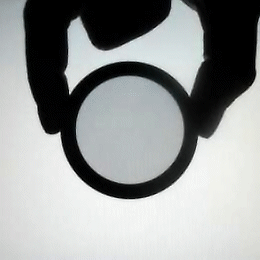The James Randi Educational Foundation (JREF) famously offers $1000000 to anyone who can demonstrate paranormal abilities. Its has helped to stem the spread of pseudoscience. The Quantum Randi Challenge is quite similar (although its main purpose for you personally is to teach you quantum mechanics intuitively): The large reward it offers is instant fame. Whoever overcomes the challenge would deserve a Nobel Prize in physics! But the Quantum Randi Challenge does not depend on a foundation that is at times discredited as colluding in establishment conspiracy.
In order to be effective in this way, the Quantum Randi Challenge (QRC) has to be totally transparent and accessible to a wide audience (YOU!). In order to archive this crucial aspect of the challenge, it has now been updated (http://arxiv.org/abs/1207.5294) with yet simpler proofs and several heuristic explanations that make the involved quantum mechanics easily understood without involving any quantum formalism [Update: Didactic part now also defended in Annals of Physics, see below]. The important angular dependence is motivated as natural from what anybody can check and often already knows from playing around with polarized sunglasses!

The physical setup is the well known, simplest Einstein-Podolsky-Rosen setup involving Alice and Bob and a light source in the middle. They measure some property to do with the polarization direction of the light, namely Alice can either obtain measurement result A = 0 or A = 1. Bob can get either B = 0 or B = 1.
The relation with sunglasses is made right away:
Alice has a calcite crystal, also called ‘polarizing beam splitter’, which has two output channels. Alice’s photon either exits channel “1”, which leaves it horizontally polarized, or channel “0”, which leads to vertical polarization (relative to the crystal’s internal axis). The measurement is recorded as A = 1 or 0, respectively. This works just like with Polaroid sunglasses, which also split light into two polarized ‘outputs’. The sunglasses absorb one ‘output’ channel while the crystal outputs both into slightly different directions behind the crystal. Source: [http://arxiv.org/abs/1207.5294]


Every photon pair created in the light source is prepared so that if the two crystals at Alice’s and Bob’s places are aligned in parallel, only the outcomes (A,B) = (0,1) and (1,0) can result. In other words, they will not get the same outcomes, say (1,1). This is called anti-correlation (AC) and reminds of crossed polarizing lenses for a reason. The underlying reasons for this can be heuristically motivated with well known classical symmetries like angular momentum conservation*.

If Alice’s crystal is at an angle δ relative to Bob’s, the outcomes depend on δ. But how do they depend on δ? This can be motivated easily. If δ = 0, the crystals are parallel to each other as described above. Therefore, one has anti-correlation (AC), which implies that if Bob observes B = 1, Alice will get A = 0. Alice’s un-measured photon behaves as if polarized orthogonally to Bob’s measured one (Photon polarization).
It must be stressed that we should not think of Alice’s photon being actually flipped to a certain polarization direction, triggered by Bob’s measurement! Such is untrue, because the light speed limit forbids any information from Bob’s measurement to arrive at Alice’s place in time for her measurement**. Nevertheless, if δ = 0, Alice’s photon behaves as if polarized orthogonal to Bob’s measurement outcome. However, δ may not even have been selected yet, say if Alice is further away from the photon source than Bob and she delays her choice of the crystal's alignment a sufficiently long time (For hairsplitters: all times here relative to the EPR setup). Therefore, it is naturally expected that her photon behaves as if polarized orthogonally to Bob’s photon at all angles δ (which is precisely what it does).

Being thus effectively polarized, and with the calcite crystals being polarizing filters, the photon behaves exactly as known from polarizing sunglasses! Polarizing filters split the light’s electrical field vector into orthogonal components. It is simple geometry of projections (which is a fancy way of saying "casting shadows") that the two orthogonal components are the sides of a right-angle triangle. The original polarization direction is the longest side of the triangle. So the components are proportional to sin(δ) and cos(δ). You do not even need to know optics, because this already works with a rope and a grid:

Energy is proportional to the square of the field vectors, so energy is conserved: sin2(δ) + cos2(δ) =100%; that is just the Pythagorean Theorem. Lay persons can even check this dependence with polarizing sunglasses (and a photo diode and voltmeter if they want to be exact about it).

Energy is directly proportional to the number of photons, thus the photons obey these factors as their probabilities for reaching the output channels, or else classical optics as we know it would not arise. The photon therefore ends up with a probability proportional to sin2(δ) at one of the output channels of the crystal, as is usual for any polarized photon that meets a polarization filter (no "quantum weirdness"). Therefore, at arbitrary angles, the outcomes (0,0) [as well as (1,1)] occur in the proportion sin2(δ).
This very sin2(δ) is precisely what infamously violates the famous Bell inequality, which in turn disproves direct realism (as is explained on a lay level in the QRC paper and my related blog posts as well as somewhat indirectly in this essay). As you can see, you do not need any sophisticated quantum formulas in order to understand the most important part of the very quantum experiment that disproves the naive realism that holds that the universe is simply “really out there”.
This is why teachers, artists, first semester philosophy students, YOU, can all help to make the Quantum Randi Challenge visually attractive and intuitive and thus known to everybody. It is not about fighting with silly crackpots; it is about educating people as well as possible about the most important result of modern physics: The universe is not just naively “really out there”. You are a conscious aspect of something more intriguing than some smelly old box with particles bumping around inside.
-------------------
* For example, if the photon-pair is prepared with zero overall rotation and Alice’s photon is observed to be circularly polarized, meaning its electrical field vector rotates a certain way (say clockwise), then Bob’s photon must rotate the opposite way, because the total rotation is still zero. The anti-correlation reflects the consistency of the behavior of photons with classical optics, which the photons give rise to and that lay persons can understand. (This does not claim to derive quantum physics. Photons are already quantum objects.)
** The actual mechanism involves other “worlds” [see EPR internet guide], NOT(!) superluminal signals.
*** My arguments are especially easy to follow with the singlet state used in the EPR experiment. That does not make them wrong if one uses a different state that would lead to more complicated correlations. It is sufficient to understand the simplest case. With photons, correlations depend on cosine and sine square of the angle. In EPR-B experiments with electrons, it depends on the cosine and sine square of the half angle. That does not render the arguments with photons wrong, but simply requires different “sunglasses” for electron experiments.
Update: Didactic part introduced and defended in:
S. Vongehr: “Exploring Inequality Violations By Classical Hidden Variables Numerically.” Annals of Physics 339: 81-88 (2013), www.sciencedirect.com/science/article/pii/S0003491613001863 Preprint version adds section on realisms and shows programs with output: arxiv.org/abs/1308.6752





Comments